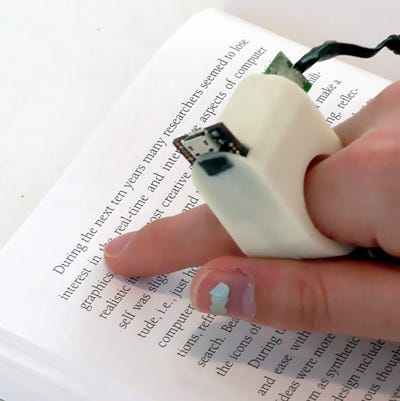July 8, 2014
Researchers at the Massachusetts Institute of Technology have developed a prototype ring with a camera that allows a visually impaired person to "read" by scrolling a finger along a line of text--with software allowing a mobile phone or laptop to speak the words to the blind person in real time.
|
The FingerReader, as shown in an MIT-provided image. |
Worn on the index finger, the FingerReader is a ring-shaped device that includes a small camera along with haptic actuators that provide the user with feedback. A visually impaired person can use the device to read text by pointing their finger at it, causing the device to read the chosen text aloud. The user can speed up or slow down the reading of the text, as well as repeat chosen words, according to a FAQ document from the MIT Media Lab. In addition, the system offers haptic feedback if the users hand inadvertently moves away from the line of text that was initially selected.
The FingerReader is still only a proof of concept prototype. But it is a great example of a productive use--and a medical-related one at that--for a wearable technology.
There has been plenty of hype as well as skepticism� around the idea of wearable technology in the form of rings.
Rings are probably the smallest cousins in the world of smart glasses such as Google Glass and smart watches including the much-rumored iWatch that could prove useful in a host of areas including healthcare. But they include technical challenges.
A startup called SmartyRing, for example, has raised hundreds of thousands of dollars on the crowdfunding site Indiegogo. The SmartyRing is supposed to serve as a clock, as well provide alerts from and serve as a remote control for an iOS or Android-platform smartphone, but it has been plagued by continual delays when it comes to delivering its finished smart ring devices to supporters.
"At a certain point, when hardware gets so small, it becomes less and less useful. Let's call it the law of diminishing devices. ... Finding room for all of the sensors--to say nothing of the battery--in a bracelet or watch is a minefield, doing so with a ring is the Temple of Doom," Kelsey Campbell-Dollaghan writes in Gizmodo.
When it comes to the FingerReader, the MIT research team kept the design simple--as well as useful.
Their FAQ sheet also points out more uses beyond helping the blind to read without Braille: "While most of our work so far has gone into helping visually impaired, the same approach of a ring on the finger could be used to help people that are not impaired with reading and pronouncing words in another language, translating from another language or maybe even help young children learn to read. We are very interested in exploring these other applications of the device."
There are already a number of smartphone applications targeted at capturing and analyzing printed text with mobile devices. But the FingerReader provides real-time feedback. Plus, it "maintains the connection of the finger to the medium, by instrumenting a well-practiced gesture of using the index finger to trace written text," according to the FAQ sheet.
Refresh your medical device industry knowledge at MEDevice San Diego, September 10-11, 2014. |
Chris Newmarker is senior editor of MPMN and Qmed. Follow him on Twitter at @newmarker.
Like what you're reading? Subscribe to our daily e-newsletter.
About the Author(s)
You May Also Like



